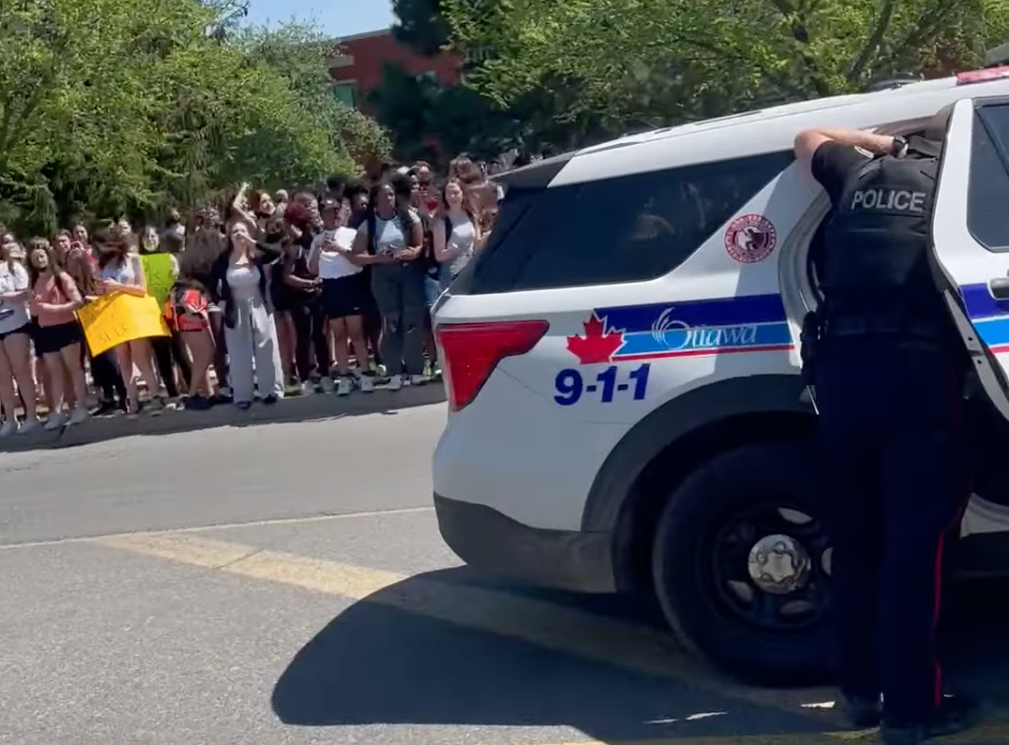Ottawa police are being criticized for their response to a student protest outside a Catholic high school over a dress code “blitz,” particularly in contrast to how they responded to the “Freedom Convoy” blockade earlier this year.

Students held a large protest outside Béatrice-Desloges Catholic High School in Orléans during lunch break Friday, a day after students say teachers called several female students out of class for alleged violations of the school dress code.
Protesters said Thursday’s “blitz” explicitly targeted females, who were taken to the principal’s office to have their shorts and skirts measured by — and in front of — male and female staff members.
“They were getting us to bend over and touch our toes to prove our underwear wasn’t showing, and were touching the inside of our thighs to measure us — which is sexual assault, because we did not consent,” said Cloé Dumoulin, a student at the school.
Dumoulin and another student, Cheyenne Lehouillier, said up to 60 students were told to change clothes or to go home and come back with a different outfit. None of the students targeted were male, they said, who were also wearing shorts and sleeveless shirts due to the 30-degree weather.
The pair were among more than 100 students who mounted a demonstration in front of the school Friday against staff’s treatment of the students. Many wore shorts in protest.
Police said in a statement they responded to what they called a “disturbance” at the school around 11:30 a.m. in order to assist staff. They said one person was arrested “for causing a disturbance and trespassing,” but was later released without charges, adding that person was not a student at the school.
However, videos posted to social media showed police putting hands on more than one person as they responded to a group of students who were protesting across the street in solidarity, according to Dumoulin and Lehouillier.
Those students were seen in the videos yelling loudly at police, including one person who was seen being taken by officers to a police car where he was pushed up against the side of the vehicle and later handcuffed and placed inside the cruiser.
“He didn’t even touch (the officer),” Dumoulin said. “(The officers) were being so aggressive, telling everyone if they crossed the street they would get a fine. It was way over the line.”

Get daily National news
The French Catholic school board, the Conseil des écoles catholiques du Centre-Est, said they could not verify who called police.
A spokesperson confirmed none of the students who had altercations with police were from Béatrice-Desloges.
The police response quickly prompted outcry from social media users, as well as concern from elected officials in the city.
City Coun. Catherine Kitts, whose ward includes Béatrice-Desloges, questioned the police handling of the students and youth attending the protest in light of how police responded to the convoy that blockaded city streets for three weeks in January and February.
“After everything that our city has been through recently and to see a pretty hands-off approach to those protests, and then to see this happen, I absolutely think there should have been greater de-escalation,” she told Global News.
“I think as long as there wasn’t a threat to the safety of other students, it was not dealt with appropriately.”

City councillors and residents admonished police during the “Freedom Convoy” protests for not doing enough to quell noise, including incessant horn blasts that lasted throughout the night and disturbed downtown residents.
Reports also emerged from local residents soon after the convoy’s arrival on Jan. 28 describing encounters with participants that they said constituted abuse, harassment, intimidation and hateful conduct.
It took police an additional week after the federal government invoked the never-before-used Emergencies Act until the blockade was finally cleared in late February.
When pressed by Global News as to what necessitated their response to Friday’s student protest, Ottawa police sent along the definition of a “disturbance” as outlined in the Criminal Code.
The Code defines a disturbance in part as “fighting, screaming, shouting, swearing, singing or using insulting or obscene language” — a definition Kitts agrees applies as much to the convoy protests as it did to the student demonstration.
“If they were there (on Friday) to just control the crowd, then I don’t understand why hands were placed on any individual,” Kitts said.
Kitts said she has spoken with interim Chief Steve Bell and plans to raise the issue further with police and the school board.
The Conseil des écoles catholiques du Centre-Est said in a statement in French that it “takes very seriously” the allegations against teachers enforcing the dress code blitz, and has sent two officials to the school to meet with students and staff.
The spokesperson said the board and the school will “continue to dialogue” about the dress code to “ensure that a positive, healthy and safe learning environment is provided for all students.”
Dumoulin and Lehouillier said while superintendent of education Jason Dupuis apologized to students for the way the blitz was conducted, school staff have yet to apologize.
The students say until an apology is made and meaningful changes to the dress code and its enforcement are announced, they and other schools are planning a walkout next Tuesday.
“We just want to know that our voices were heard, and that they’re going to do something about it,” said Lehouillier. “Because this was not OK.”
— with files from Global News’ Amanda Connolly








Comments